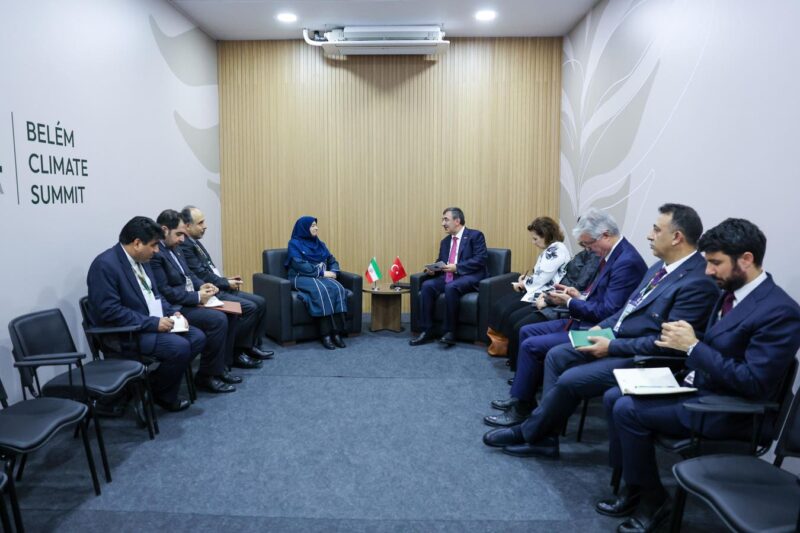NOVEMBER 2025- Iran’s Vice President Shina Ansari meets with the Turkish delegation during her visit to Belém for the COP30 UN Climate Change Conference in Brazil- (Photo by Ahmet Okur/Anadolu via Getty Images).
Anadolu via Getty Images
Drought, floods, heatwaves, wildfires and sand and dust storms.
As the United Nations Climate Change Conference in Belém wraps up, Iran is grappling with a range of environmental problems that climate change is making worse.
Across Iranian provinces, severe water shortages have led to periodic cuts and rationing – with reservoirs supplying major cities such as Tehran and Mashhad nearly empty. Years of consecutive drought and record low precipitation levels have prompted authorities to turn to cloud seeding to help with rainfall.
But studies indicate that when too much water is extracted from the ground, the soil collapses and becomes compacted. It can then no longer absorb rain, so water runs off instead of refilling aquifers, increasing the risk of floods – an occurrence that happened in a number of western provinces in recent days.
In Mazandaran Province up north, wildfires have been burning for more than two weeks in the Hyrcanian forests – a green belt between the Caspian Sea and the Alborz mountains – driven by heat, wind, and dry vegetation.
Over the summer, in the southern parts of the county in Khuzestan, Sistan and Baluchistan and Bushehr, temperatures surpassed 50 degrees Celsius (122 degrees Fahrenheit), making them some of the hottest places on the planet.
Land subsidence – the sinking of land – has become a serious problem in places like Tehran, Isfahan and Shiraz, now among the fastest subsiding areas in the world that are already damaging roads, buildings and schools.
The main drivers of Iran’s environmental challenges are decades of poor management, an inefficient agriculture sector and unsustainable development. Climate change is now intensifying these problems, and the manner in which Iran responds will have impacts beyond its borders to the wider Middle East region.
What Happened At COP30
Iran’s delegation arrived in Belém this month, led by the head of the Department of Environment, Shina Ansari. In her speech to the UN summit attendees, Ansari acknowledged the risks the country faces from climate change.
Reports show Iran is warming around twice as fast as the global average, with temperatures expected to rise by about 2.6 degrees Celsius by 2030 – a trend that is already adding to the harshness and severity of droughts and heatwaves.
In her address, Ansari said Iran is taking “some measures” to reduce greenhouse gas emissions, including plans to expand solar and other renewable energy to lower the use of fossil fuels. But much of her remarks focused on the US and European sanctions on Iran, which she said “limit access to modern technology” and “the foreign investment” the country needs.
Iran’s nuclear and missile programs, as well as its regional activities, are among the reasons behind its isolation from the West and the international community.
Ansari also pointed to the 12-day war with Israel in June, saying the attacks on Iran’s nuclear facilities caused environmental damage and significantly added to carbon emissions, especially in the heavily bombed Tehran.
The Department of Environment’s trip to COP30 was questioned over costs and expenses, with hardline members of parliament accusing Ansari of overspending the budget. However, in statements and social media posts, Ansari posted detailed explanations of the costs and rejected the claims.
But Iran’s history at UN climate change conferences tells a similar story. Last year at COP29 in Azerbaijan, officials again pointed to sanctions – and the war in Gaza – as reasons for the country’s failure to tackle climate change.
At COP28 in the United Arab Emirates in 2023, Iranian representatives walked out of the UN climate talks in “protest” at the presence of officials from Israel. At the time, the Energy Ministry and the head of the delegation said they left the venue because “Israel’s participation” was “contrary to the conference’s goals and guidelines.”
A couple of years back, at COP27 in Egypt and at COP26 in the United Kingdom, “technological and financial” limitations from sanctions were also blamed for Iran’s lack of action towards climate change.
The Road Ahead
According to the Climate Change Performance Index, which ranks countries on their commitment to fighting global warming, Iran is listed among the three worst-performing nations after the United States and ahead of Saudi Arabia.
Iran is considered one of the top ten carbon emitters and is the only country, aside from Yemen and Libya, that has signed but not ratified the landmark Paris Agreement aimed at keeping global temperatures at a certain point.
The last time the Islamic Republic pledged to reduce emissions was in 2015, and it still has not submitted a Nationally Determined Contribution, even as many other countries in the Middle East have already done so.
Meanwhile, with Turkey selected to host the following UN climate change summit (COP31) next door, Iran’s environmental problems are growing, and its response to climate change hangs in the balance.








